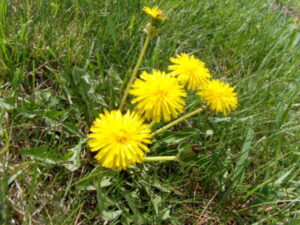I learned some interesting tidbits while reading through an old cookbook my aunt gave me. The cookbook contained stories and recipes from the 1930s, the Great Depression years. Today, I’ll share some of the interesting facts gleaned from the cookbook.
Tomatoes for breakfast
One thing I noted was that when families didn’t have oranges for vitamin C, they ate tomatoes for breakfast served with sugar and cream. My husband would like this since he is a tomato-crazy kind of guy. During tomato season, he eats a whole dinner-plate of tomatoes just himself. If you’re like him, you might like to try this unusual (for today) breakfast.
Nylon mending gadget
Another note of interest was that they had a gadget to mend nylons! Now, I would have liked a gadget like that back during my corporate business days. I bought lots of nylons then. A perfect pair of nylons could develop a run during the first wearing, which infuriated me since they weren’t inexpensive. Today, nylons seem to have fallen from fashion. This is great in my opinion. Think of how much money we save now that we don’t have to buy nylons! If they ever return to fashion—which they may since fashions seem to come around again after time—I hope they bring back the nylon mending gadget too.
Making coffee last longer
One way people in this era saved money was to add water to the coffee grounds throughout the day to stretch the coffee. I’m not a coffee drinker, but my husband is. He likes his strong, but if pennies needed to be pinched, he would likely prefer this method to no coffee at all. What do you think about this?
Egg noodles
According to the cookbook’s author, Rita Van Amber, women used their extra eggs to make egg noodles because egg prices were so low that it didn’t pay to sell them. Some farmers fed extra eggs to their pigs instead, but others used them to make the noodles to make noodle hot dishes to stretch their food. Recipes included ham noodle casserole and chicken noodle casserole that did not include condensed soup like today but gravy instead. One innovative mom made a casserole with cabbage, celery and onion with her noodles. An exact recipe of this appeared in Bon Appetit magazine.
Dandelions

The last piece of interest is about dandelions. In the spring, these yellow flowers pop up along the roadsides and in yards. My youngest loves dandelions. My husband calls them weeds and tries to rid our yard of them which is upsetting to a dandelion lover. Nevertheless, I have a solution that I found within the pages of this cookbook: we can eat them. Don’t eat them if they have been sprayed, of course, but if you could restrain your weed killing family member, you might try a dandelion salad or dandelion wine.
Again, according to Amber, “no meal was more eagerly awaited for and enjoyed with more relish than the springtime dandelion dinner.” The tender leaves and stems were washed and tossed into a pan of equal parts vinegar and bacon drippings. Several hard boiled eggs were sliced over the greens, and a hot, boiled potato was crushed into it. A hot, vinegar dressing was poured over the salad, which was then tossed and enjoyed with a meal of boiled potatoes and bacon or pork.
Tough times

You can also steam the dandelion greens or prepare like spinach. A drought from 1933-1937 caused people to depend on dandelions, lambs quarters (another kind of green), wild berries and nuts, and to use every part of an animal when butchered. Today our abundance and large supermarkets spoil us.
To make dandelion wine, you need a gallon of dandelion flower heads. The cookbook includes a detailed recipe. Have you ever eaten a dandelion greens salad or drank dandelion wine? I’m wondering about your experience. Please share it with us!
Here is one modern recipe. Because of the cookbook copyright, I won’t share the original.
Breads
Women during this time also made a lot of wholesome breads. I’ve started trying some of the recipes in the cookbook. Although times were tougher, their recipes are healthier, less fattier, according to the author.
I have another old cookbook that tells me to skin the rabbit, etc. before making the recipe. I keep it for its historical value because as you may have guessed, I have never skinned a rabbit. Both cookbooks came to me via family members so that makes them extra valuable too.
Do you have any cookbooks from the early1900s? What recipe jumps out in it for you?
Discover more from Michelle Kaderly Welsh
Subscribe to get the latest posts sent to your email.




6 Responses
Very interesting. I enjoy tomatoes for breakfast, too. 🙂
Thanks, Melissa. Hey, if you lived closer, I’d share my tomatoes with you. 🙂 We often have plenty!
I have an old notebook from my grandmother with her recipes from the Great Depression. It includes recipes for soap and various “ailments,” such as rheumatism. They often ate “mystery soup,” and I included this dinner in a scene in my historical fiction book More Than Grit.
That sounds like a wonderful treasure, Gretchen! Having the recipes in her own handwriting is extra precious too. I think I remember that, now that you mention it. I love your book, More Than Grit! I’m looking forward to the sequel. 🙂
Interesting blog, Michelle. It reminded me I have and old cookbook, too – “The Original Fannie Farmer 1896 Cook Book.” It was given to me as a Christmas gift from my mother-in-law way back in the 1950s when I was still a young bride. I’m ashamed to say I have never made anything from it. I will have to take some time and go through it again. Thanks for the reminder.
Wow! That’s a collectible maybe. I bet you will find some interesting recipes and notes within its pages, Donna. Thanks for sharing. Let me know what you discover. 🙂